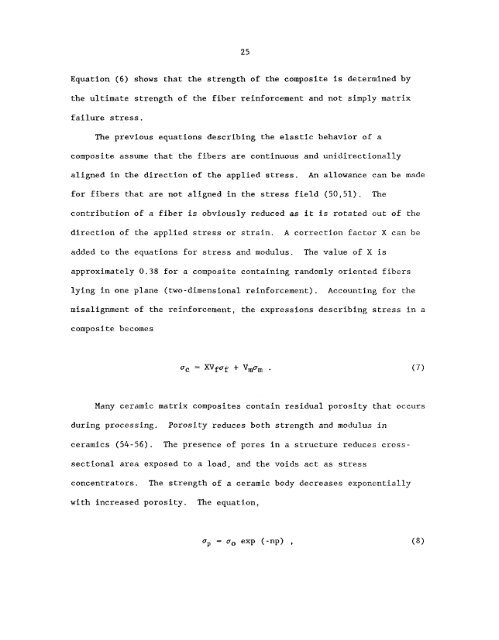Characterization and control of the fiber-matrix interface in ceramic ...
Characterization and control of the fiber-matrix interface in ceramic ...
Characterization and control of the fiber-matrix interface in ceramic ...
Create successful ePaper yourself
Turn your PDF publications into a flip-book with our unique Google optimized e-Paper software.
25<br />
Equation (6) shows that <strong>the</strong> strength <strong>of</strong> <strong>the</strong> composite is determ<strong>in</strong>ed by<br />
<strong>the</strong> ultimate strength <strong>of</strong> <strong>the</strong> <strong>fiber</strong> re<strong>in</strong>forcement <strong>and</strong> not simply <strong>matrix</strong><br />
failure stress.<br />
The previous equations describ<strong>in</strong>g <strong>the</strong> elastic behavior <strong>of</strong> a<br />
composite assume that <strong>the</strong> <strong>fiber</strong>s are cont<strong>in</strong>uous <strong>and</strong> unidirectionally<br />
aligned <strong>in</strong> <strong>the</strong> direction o f <strong>the</strong> applied stress.<br />
An allowance can be made<br />
for <strong>fiber</strong>s that are not aligned <strong>in</strong> <strong>the</strong> stress field (50,51). The<br />
contribution <strong>of</strong> a <strong>fiber</strong> is obviously reduced as it is rotated out <strong>of</strong> <strong>the</strong><br />
direction <strong>of</strong> <strong>the</strong> applied stress or stra<strong>in</strong>. A correction factor X can he<br />
added to <strong>the</strong> equations for stress <strong>and</strong> modulus. The value sf X is<br />
approximately 0.38 for a composite conta<strong>in</strong><strong>in</strong>g r<strong>and</strong>omly oriented <strong>fiber</strong>s<br />
ly<strong>in</strong>g <strong>in</strong> one plane (two-dimensional re<strong>in</strong>forcement).<br />
Account<strong>in</strong>g for <strong>the</strong><br />
misalignment <strong>of</strong> <strong>the</strong> reznforcement, <strong>the</strong> expressions describ<strong>in</strong>g stress <strong>in</strong> a<br />
composite becomes<br />
Many <strong>ceramic</strong> <strong>matrix</strong> composites conta<strong>in</strong> residual porosity that OCCU~S<br />
dur<strong>in</strong>g process<strong>in</strong>g. Porosity reduces both strength <strong>and</strong> modulus <strong>in</strong><br />
<strong>ceramic</strong>s (54-56).<br />
The presence <strong>of</strong> pores <strong>in</strong> a structure reduces cross-<br />
sectional area exposed to a load, <strong>and</strong> <strong>the</strong> voids act: as stress<br />
concentrators.<br />
The strength <strong>of</strong> a <strong>ceramic</strong> body decreases exponentially<br />
with <strong>in</strong>creased porosity. The equation,

















